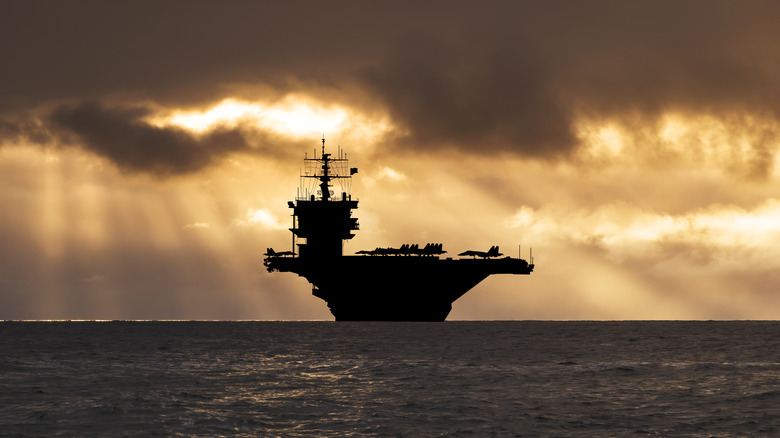What Happens To Aircraft Carriers When They Are Retired?
The United States Navy has been using aircraft carriers since 1922, when the USS Langley (CV-1) was commissioned. Ever since then, carriers have sailed all across the seven seas like steel behemoths, serving as the flagships of every fleet. The length of time a carrier is in service varies: The USS Langley (CV-1) remained in service for 29 years before it was sunk in 1942. Meanwhile, the USS Ranger (CV-4) only served for 12 years before it was decommissioned. That said, The creation of nuclear-powered carriers ensured that these floating command centers can serve a commission for at least 50 years.
When a carrier is retired, otherwise known as a "decommissioning," they are sent into a port and stripped for spare parts and materials. Some carriers are sold to other countries, allowing the United States to make some money rather than losing it by paying a third party to scrap it. On occasion, though, after a carrier has been stripped of every last useful spare part, the Navy will donate the ship to serve as a museum for the public. One such museum is the USS Midway (CV-41) in San Diego, California.
The Navy has been known to get creative in the past. When the Navy decommissioned the USS Forrestal (CV-59), it was meant to become a museum. Unfortunately, that didn't work out, so the Navy considered sinking it and turning it into an artificial reef. Unfortunately, that idea also fell through and the ship was simply given to a scrapping company.
What about nuclear aircraft carriers?
Retiring a nuclear carrier is a little trickier than older carriers because there's the matter of their nuclear cores, which are radioactive and dangerous. When a nuclear vessel is decommissioned, the nuclear waste has to be safely transported as per Department of Transportation guidelines, and disposed of under Department of Energy supervision. While the Navy has decommissioned multiple nuclear vessels over the years, the USS Enterprise (CVN-65) has been the first nuclear carrier. It has been sitting in Newport News, Virginia since its decommissioning in 2012. So, what's the plan for a nuclear carrier after its retirement? Unfortunately, it won't undergo the process of becoming a museum.
The Department of Defense ultimately decided to scrap the ship and recycle any part it can. In only a few short years, the USS Nimitz will also nestle itself into retirement and join the Enterprise. These two ships might be similar, but they're also vastly different due to the Enterprise having eight nuclear reactors versus the Nimitz's two.
According to Jamie Koehler, a Naval Sea Systems Command spokeswoman, "Enterprise and Nimitz are similar in that they are large, rugged ships containing low levels of various hazardous materials. However, they are of considerably different design, so the approach to inactivation will reflect those differences."
There are no nuclear aircraft carrier museums yet, but maybe the public will get one with the USS Nimitz or the USS Dwight D. Eisenhower (CVN-69), which are planned to be decommissioned in 2027.
American carriers that became museums
As of 2024, there are five floating aircraft carrier museums in the United States. The Navy commissioned the USS Intrepid (CV-11) in August 1943, and served in the Pacific for the end of World War II. After the Navy decommissioned the Intrepid in March 1974, a plan to scrap it was in place. However, the Intrepid Museum Foundation fought to keep it as a museum instead. They won the battle, and the USS Intrepid Museum opened in New York City, New York in August 1982, where it's humbly docked at Manhattan's Pier 86. Down south in Mount Pleasant, South Carolina, rests the USS Yorktown (CV-10), another carrier that served in the Pacific during World War II.
The Yorktown lived out its usefulness until June 1970, when the U.S. Navy decommissioned her. The ship was towed to South Carolina in 1975, where it became a part of the Patriots Point Naval & Maritime Museum, alongside the destroyer USS Laffey (DD-724). A hop over to Corpus Christi, Texas, and visitors can explore the decommissioned USS Lexington (CV-16) that served honorably from 1943 to 1991. This is another carrier that saw action in the Pacific during WWII and took part in the raid on Kwajalein Atoll in December 1943.
California residents are lucky enough to host two carriers as museums. The USS Midway (CV-41) calls San Diego, California home while the USS Hornet (CV-12) quietly rests up north in Alameda, California, right across the bay from San Francisco.


